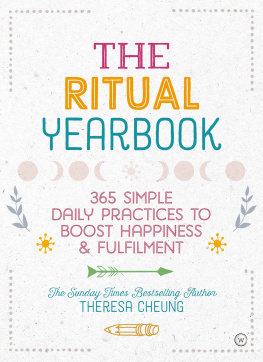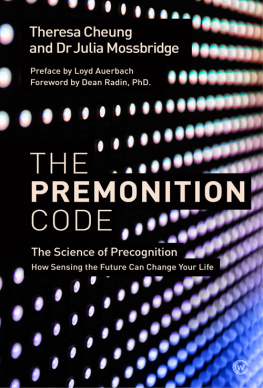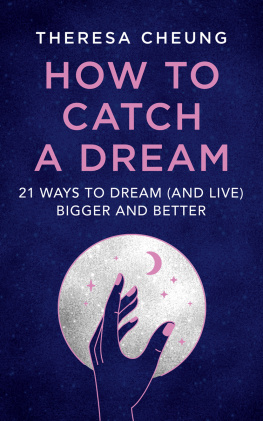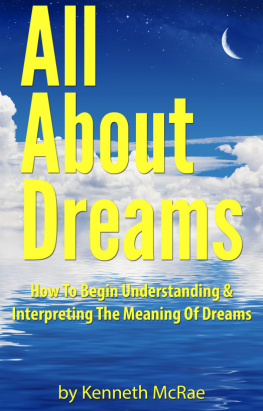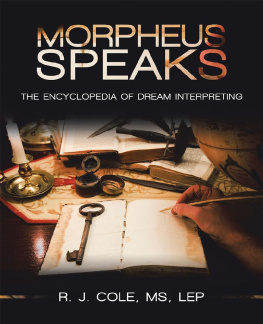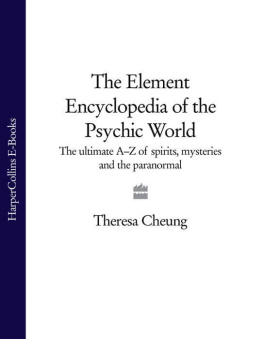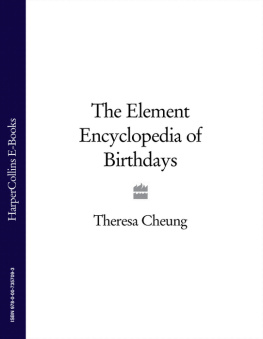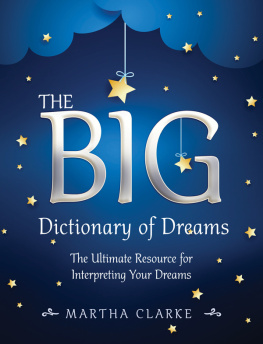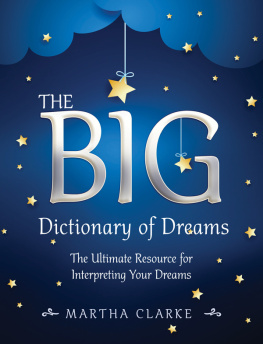Theresa Cheung - The Element Encyclopedia of 20,000 Dreams: The Ultimate A-Z of Interpreting the Secrets of Your Dreams
Here you can read online Theresa Cheung - The Element Encyclopedia of 20,000 Dreams: The Ultimate A-Z of Interpreting the Secrets of Your Dreams full text of the book (entire story) in english for free. Download pdf and epub, get meaning, cover and reviews about this ebook. year: 2007, publisher: Harper Element, genre: Religion. Description of the work, (preface) as well as reviews are available. Best literature library LitArk.com created for fans of good reading and offers a wide selection of genres:
Romance novel
Science fiction
Adventure
Detective
Science
History
Home and family
Prose
Art
Politics
Computer
Non-fiction
Religion
Business
Children
Humor
Choose a favorite category and find really read worthwhile books. Enjoy immersion in the world of imagination, feel the emotions of the characters or learn something new for yourself, make an fascinating discovery.
- Book:The Element Encyclopedia of 20,000 Dreams: The Ultimate A-Z of Interpreting the Secrets of Your Dreams
- Author:
- Publisher:Harper Element
- Genre:
- Year:2007
- Rating:5 / 5
- Favourites:Add to favourites
- Your mark:
- 100
- 1
- 2
- 3
- 4
- 5
The Element Encyclopedia of 20,000 Dreams: The Ultimate A-Z of Interpreting the Secrets of Your Dreams: summary, description and annotation
We offer to read an annotation, description, summary or preface (depends on what the author of the book "The Element Encyclopedia of 20,000 Dreams: The Ultimate A-Z of Interpreting the Secrets of Your Dreams" wrote himself). If you haven't found the necessary information about the book — write in the comments, we will try to find it.
The Element Encyclopedia of 20,000 Dreams: The Ultimate A-Z of Interpreting the Secrets of Your Dreams — read online for free the complete book (whole text) full work
Below is the text of the book, divided by pages. System saving the place of the last page read, allows you to conveniently read the book "The Element Encyclopedia of 20,000 Dreams: The Ultimate A-Z of Interpreting the Secrets of Your Dreams" online for free, without having to search again every time where you left off. Put a bookmark, and you can go to the page where you finished reading at any time.
Font size:
Interval:
Bookmark:
W hat if you slept, and what if in your sleep you dreamed, and what if in your dream you went to heaven and there plucked a strange and beautiful flower, and what if when you awoke you had the flower in your hand? Ah, what then?
Samuel Taylor Coleridge
A dream can sometimes feel incredibly realas if the sensations experienced are actually happeningbut then as we wake up to everyday reality we cannot make sense of anything and wonder what it all meant.
Most dream analysts believe that dreams are not meaningless but littered with messages from our unconscious. They are inner communications that, if heeded, have the potential to set us on the road to a richer, more fulfilling path in waking life. Sadly, many of us forget our dreams upon waking and this is a great loss. According to the Talmud: A dream which is not interpreted is like a letter which is not read.
If we are to remember, understand and work with the messages from our unconscious minds, we first need to learn how to interpret them. The Element Encyclopedia of 20,000 Dreams is an illuminating and comprehensive exploration of the symbols that appear in our dreamscape, and a rich source of information to help you unlock the messages, possibilities, richness and wisdom of your dream world. Use it to find out the fascinating things your dreams are trying to tell you!
T he Element Encyclopedia of 20,000 Dreams is arranged in three parts: the Introduction, the main section covering the Dreams themselves, and the Dream Directory.
The Introduction discusses the hows, whats and whys of sleep and dreams, the complexities of dream interpretation and what you need to know about unlocking the meaning of your dreams.
The Dreams is the main section of the book. Dream messages can be difficult to decipher until you have learned their secret language; this section will give you the key to your unconscious minds wealth. The entries are arranged in sixty thematic chapters, beginning with ACCIDENTS, ACTION AND ADVENTURES and finishing with WEATHER, and cover approximately 20,000 different dreams. Each chapter begins with a short introduction that talks about the kind of dreams covered in the section. The dream entries that follow are arranged in thematic order and youll also find cross references to relevant dream entries elsewhere in the book. Some chapters also contain an A to Z of relevant dream objects and situations. You can dip into this massive resource to gain insight into a specific dream you may have had; for example, if you dreamt about a horse you can look for it in the chapter devoted to the theme of animals. Here you will be able to read about specific horse dreams, but at the same time you can cast your eye on entries covering similar or related animal topics which may throw light on your particular dream.
For ease of reference you may prefer to first turn to part three of the book: The Dream Directory. This lists every dream entry in the book in alphabetical order, so it is simple to look up specific dreams; it also functions as a cross-reference to other relevant entries.
I dream, therefore I exist.
J. August Strindberg
Dreams. They tantalize us with their mystery. What are they? Why do we have them? Where do they come from? What do they mean? Are they a preview of things to come or glimpses of the past? Are they a vital link to our inner world; a gift from our intuition? Can dreams lead us to important insights in our waking life, and help us decide which action to take and which path to follow?
Sleep is the balm for hurt minds, natures great second course. William Shakespeare
Sleep is absolutely crucial for our physical, mental and emotional health and well-being. It is during sleep that we abandon conscious control of our physical body and the unconscious mind is allowed to roam free, giving rise to dreams.
Although we now know a lot more about dreams, their real purpose isnt yet fully understood. It wasnt until we approached the middle of the twentieth century, with the first electronic monitoring of the brain, that we began to get a clearer idea of the nocturnal adventures of the mind. For centuries it was thought that the purpose of sleep was to rest the body and the mind, but this reasoning was disproved when it was shown that both the body and mind are active during sleep. If sleep doesnt rest the body or mind, then what is it for?
Sleep researchers may not yet have discovered the exact reason for sleep or dreams but they have discovered some fascinating things. For example, it seems that when we are asleep our brains are a bit like computers that are offline. This means they are not idle but are filing and updating the days activities. They take stock of your body and release a growth hormone to repair damaged tissues and stimulate growth, while the immune system gets to work on attacking any viral or bacterial infections that may be present. Some experts believe the brain also jettisons trivial information during sleep to prevent it becoming overburdened with unimportant information, but this explanation is perhaps too simplistic, as no memory can be totally eradicated.
The advent of space travel gave scientists the opportunity to prove that resting the body was not the main function of sleep. What they found instead was that prolonged periods of isolation decreased the need for sleep. In other words, the fewer stimuli received from people or external contacts during the day, the less sleep was required. It seems we have a sleep control center at the base of our brain linked with activity during wakefulness. When that gets overloaded we get tired, but if there have not been enough stimuli from the outside world, the sleep mechanism isnt triggered. It seems, therefore, that boredom and lack of stimuli may account for many cases of insomnia. (Paradoxically, overstimulation also produces insomnia.)
Yet it is in our idleness, in our dreams, that the submerged truth sometimes comes to the top. Virginia Woolf
Perhaps the best way to understand sleep and dreams is to understand the brain. At the very start of the twentieth century it was found that the brain gave off electrical impulses, and by the 1920s scientists could measure brain waves. To obtain these readings, electrodes were attached to various parts of the head, the impulses being transformed onto electroencephalograms (EECs) on computer screens.
It seems that once you settle down to bed, your brain and body undergo radical changes from their waking state. The difference between being asleep and being awake is loss of conscious awareness, and once you start to doze, dream researchers believe you progress through four stages of sleep. These form the basis of a cycle that repeats up to four or five times every eight hours of sleep.
During the first stage, your body and mind become relaxed. Heart and breathing rate slow down, blood pressure lowers, body temperature drops slightly and eyes roll from side to side. You are neither fully conscious, nor fully unconscious, and could easily awake if disturbed. This stage of gradually falling asleep is also called the hypnagogic state (the hypnopompic state is a similar state when you are just waking up) and you may experience hallucinations that float before your eyes.
In stage two, breathing and heart rate become even slower, eyes continue to roll and you become more and more unaware of the noises of the outside world. It isnt until the third stage of sleep, however, that you are sleeping soundly and it would be difficult to wake you. Finally, you enter a deep sleep state known as non-rapid eye movement (NREM) when your brain is released from the demands of the conscious mind. It will now be quite hard to wake you and, although you may sleepwalk or have night terrors, you will rarely be able to remember them. This slow-wave sleep cycle lasts about ninety minutes. At the end of stage four, you move back through stages three and two and one, at which point you enter a phase called rapid eye movement, or REM, sleep.
Font size:
Interval:
Bookmark:
Similar books «The Element Encyclopedia of 20,000 Dreams: The Ultimate A-Z of Interpreting the Secrets of Your Dreams»
Look at similar books to The Element Encyclopedia of 20,000 Dreams: The Ultimate A-Z of Interpreting the Secrets of Your Dreams. We have selected literature similar in name and meaning in the hope of providing readers with more options to find new, interesting, not yet read works.
Discussion, reviews of the book The Element Encyclopedia of 20,000 Dreams: The Ultimate A-Z of Interpreting the Secrets of Your Dreams and just readers' own opinions. Leave your comments, write what you think about the work, its meaning or the main characters. Specify what exactly you liked and what you didn't like, and why you think so.

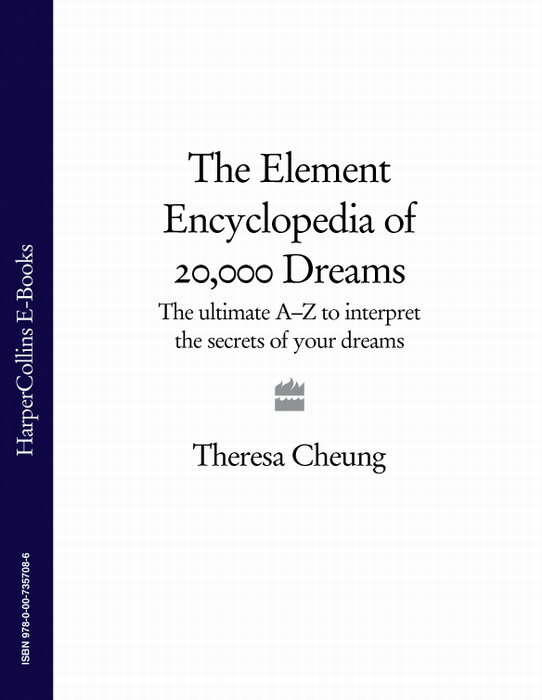
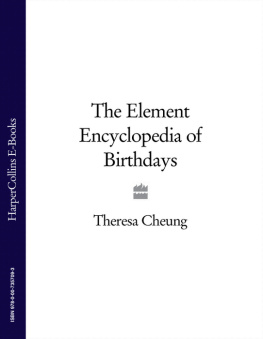
![Theresa Cheung - The Dream Dictionary from A to z; [Revised edition]](/uploads/posts/book/162615/thumbs/theresa-cheung-the-dream-dictionary-from-a-to-z.jpg)
